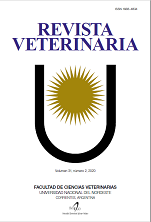Seroprevalencia y factores de riesgo del virus de parainfluenza 3 (VPI-3) en bovinos de Colombia
DOI:
https://doi.org/10.30972/vet.3124737Palabras clave:
bovino, virus de parainfluenza VPI-3, ELISA, prevalencia, ColombiaResumen
El virus de la parainfluenza bovina tipo 3 (VPI-3) es considerado como uno de los patógenos más importantes asociados con las enfermedades respiratorias bovinas. Está calificado como parte del complejo respiratorio bovino, porque es una enfermedad multifactorial asociada a la manifestación de diferentes agentes etiológicos que causan neumonía o infección de las vías respiratorias superiores, en todas las edades del ganado. Está ampliamente distribuido a nivel mundial y se caracteriza por causar síntomas como bronconeumonía grave, tos, anorexia, pirexia, secreciones nasales y oculares, disnea y -a veces- diarrea. El objetivo de esta investigación fue determinar la seroprevalencia y los factores de riesgo del virus de parainfluenza en bovinos del municipio de Oicatá (Boyacá, Colombia). Se recolectaron 360 muestras de sangre de hembras bovinas, las cuales se procesaron mediante la implementación del kit comercial ELISA PrimacheckVPI-3®, Agrolabo (España). La seroprevalencia de VPI-3 fue del 31%, sin embargo no se encontró asociación estadística con la raza y edad de los individuos evaluados. La seroprevalencia de la enfermedad es elevada en Oicatá, afectando directamente a la productividad y rentabilidad de la producción animal, razón por la cual se hace necesaria la implementación de planes de control y prevención de dicha patología.Descargas
Citas
Alcaldía Municipal de Oicatá. 2019. Nuestro municipio [Internet], disponible en http://www.oicata-boyaca.gov.co.
Ali H, Ali AA, Atta MS, Cepica A. 2012. Common, emerging, vector-borne and infrequent abortogenic virus infections of cattle. Transbound Emerg Dis 59: 11-25.
Andrade OS, Chicaiza G. 2015. Prevalencia de anticuerpos a parainfluenza bovina (PI-3) en ganaderías lecheras de Cuenca, Ecuador. Maskana 8: 209-210.
Angen O et al. 2009. Respiratory disease in calves: microbiological investigations on trans-tracheally aspirated bronchoalveolar fluid and acute phase protein response. Vet Microbiol 137: 165-171.
Betancur HC, Orrego UA, González TM. 2010. Estudio seroepidemiológico del virus de parainfluenza-3 en bovinos de Montería (Colombia) con trastornos reproductivos. Rev Med Vet 20: 63-70.
Cabello RK, Quispe CR, Rivera GH. 2006. Frecuencia de los virus parainfluenza-3, respiratorio sincitial y diarrea viral bovina en un rebaño mixto de una comunidad campesina de Cusco. Rev Investig Vet Peru 17: 167-172.
Czuprynski CJ et al. 2004. Complexities of the pathogenesis of Mannheimia haemolytica and Haemophilus somnus infections: challenges and potential opportunities for prevention? Anim Heal Res Rev 5: 277-282.
Ellis JA. 2010. Bovine parainfluenza-3 virus. In: Veterinary Clinics of North America - Food Animal Practice, Elsevier Ltd, p. 575-593.
Gálvis GT, Bautista AH, Vásquez MC. 2016. Prevalencia de anticuerpos contra diarrea viral bovina, virus sincitial bovino, rinotraqueitis infecciosa bovina, leucosis bovina, neospora caninum, parainfluenza bovina (PI3) y paratuberculosis, en ganadería bovina de fincas ubicadas en Aguachica. Rev Fac Ciencias Salud 3: 36.
Givens DM, Marley MS. 2008. Infectious causes of embryonic and fetal mortality. Theriogenology 70: 270-285.
ICA: Censo Pecuario Nacional. 2019. Disponible en:
https://www.ica.gov.co/areas/ pecuaria/servicios/epidemiologia-veterinaria/censos-2016/censo-2018.
Karle BM et al. 2019. Regional management practices and
prevalence of bovine respiratory disease in California’s preweaned dairy calves. J Dairy Sci 102: 7583-7596.
Karron RA, Collins PL. 2013. Parainfluenza viruses. In: Fields Virology, Knipe DM & Howley PM editors, 6th ed., Philadelphia, p. 996-1023.
Krzysiak MK et al. 2018. Seroprevalence and risk factors
for selected respiratory and reproductive tract pathogen
exposure in european bison (Bison bonasus) in Poland. Vet Microbiol 215: 57-65.
Lv L, Zhao G, Wang H, He H. 2019. Cholesterol 25-hydroxylase inhibits bovine parainfluenza virus type 3 replication through enzyme activity-dependent and independent ways. Vet Microbiol 239: 108456.
Maidana SS et al. 2012. Isolation and characterization of
bovine parainfluenza virus type 3 from water buffaloes (Bubalus bubalis) in Argentina. Vet Res 8: 83-91.
Murray GM et al. 2017. Evolving views on bovine respiratory disease: An appraisal of selected key pathogens. Vet J 217: 95-102.
Murray GM et al. 2016. Pathogens, patterns of pneumonia, and epidemiologic risk factors associated with respiratory disease in recently weaned cattle in Ireland. J Vet Diagn Investig 29: 20-34.
Neill JD, Ridpath JF, Valayudhan BT. 2015. Identification and genome characterization of genotype B and genotype C bovine parainfluenza type 3 viruses isolated in the United States. BMC Vet Res 11: 1-6.
Pansri P et al. 2020. Evaluation of novel multiplex qPCR assays for diagnosis of pathogens associated with the bovine respiratory disease. Vet J 256: 105425.
Pourhoseingholi MA, Vahedi M, Rahimzadeh M. 2013. Sample size calculation in medical studies. Gastroenterol Hepatol from Bed to Bench 6: 14-17.
Sobhy NM et al. 2017. Surveillance, isolation and complete genome sequence of bovine parainfluenza virus type 3 in Egyptian cattle. Int J Vet Sci Med 5:8-13.
Solís JJ, Segura JC, Aguilar F, Segura VM. 2007. Detection of antibodies and risk factors for infection with bovine respiratory syncytial virus and parainfluenza virus-3 in beef cattle of Yucatan, Mexico. Prev Vet Med 82: 102-110.
Sudaryatma PE et al. 2018. Bovine respiratory syncytial virus infection enhances P. multocida adherence on respiratory epithelial cells. Vet Microbiol 220: 33-38.
Sudaryatma PE et al. 2019. Co-infection of epithelial cells established from the upper and lower bovine respiratory tract with bovine respiratory syncytial virus and bacteria. Vet Microbiol 235: 80-85.
Thanthrige DN et al. 2018. A novel multiplex PCR-electronic microarray assay for rapid and simultaneous detection of bovine respiratory and enteric pathogens. J Virol Methods 261: 51-62.
Wathes DC, Oguejiofor CF, Thomas C, Cheng Z. 2020. Importance of viral disease in dairy cow fertility. Engineering 6: 26-33.
Zhao G et al. 2018. Development of a recombinase polymerase amplification combined with a lateral flow dipstick assay for rapid detection of the Mycoplasma bovis. BMC Vet Res 14: 1-10.
Zhao G, Wang H, Hou P, Xia X, He H. 2018. A lateral flow dipstick combined with reverse transcription recombinase polymerase amplification for rapid and visual detection of the bovine respirovirus 3. Mol Cell Probes 41: 22-26.
Zhao G, He H, Wang H. 2019. Use of a recombinase polymerase amplification commercial kit for rapid visual detection of P. multocida. BMC Vet Res 15: 1-8.
Descargas
Publicado
Cómo citar
Número
Sección
Licencia
Derechos de autor 2021 M. A. Fernández, D. M. Bulla, A. M. Díaz, M. O. Pulido

Esta obra está bajo una licencia internacional Creative Commons Atribución-NoComercial 4.0.
Política de acceso abierto
Esta revista proporciona un acceso abierto inmediato a su contenido, basado en el principio de que ofrecer al público un acceso libre a las investigaciones ayuda a un mayor intercambio global de conocimiento. La publicación por parte de terceros será autorizada por Revista Veterinaria toda vez que se la reconozca debidamente y en forma explícita como lugar de publicación del original.
Esta obra está bajo una licencia de Creative Commons Reconocimiento-NoComercial 4.0 Internacional (CC BY-NC 4.0)










.jpg)
.jpg)



